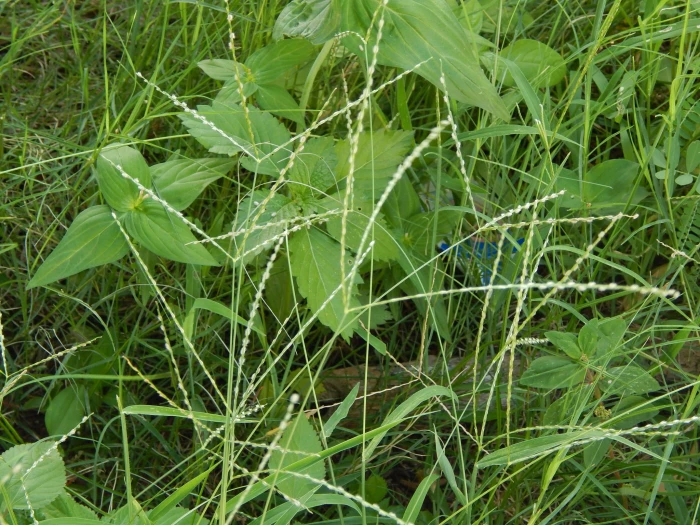Asian Crabgrass
(Digitaria bicornis)
Asian Crabgrass (Digitaria bicornis)
/
/

Breno Figueiredo
CC BY 4.0
Image By:
Breno Figueiredo
Recorded By:
Copyright:
CC BY 4.0
Copyright Notice:
Photo by: Breno Figueiredo | License Type: CC BY 4.0 | License URL: http://creativecommons.org/licenses/by/4.0/ | Rights Holder: Breno Figueiredo | Publisher: iNaturalist | Date Created: 2021-02-07T09:21:05-08:00 |

























Estimated Native Range
Climate Requirements
| • Precipitation | 4" - 148" |
| • High Temp. | 13°F - 108°F |
| • Low Temp. | -19°F - 74°F |
Summary
Digitaria bicornis, commonly known as Asian Crabgrass, is a warm-season grass that exhibits both perennial and annual growth habits, depending on its environment. It is native to tropical and subtropical regions of Asia and Africa, typically thriving in open grasslands, agricultural fields, and other disturbed sites. This species is highly adaptable and can colonize a wide range of habitats, often becoming a dominant species in disturbed soils.
Asian Crabgrass has a prostrate growth form, spreading horizontally rather than vertically, which allows it to form dense mats. It can grow rapidly to a height of 0.3-0.6 feet (0.09-0.2 meters) and a width of 0.25-2.5 feet (0.1-0.8 meters). The plant features fine-textured foliage and produces small, inconspicuous spikelets. While not grown for ornamental purposes, it is sometimes used for erosion control due to its fast growth and dense coverage. Asian Crabgrass prefers full sun exposure and is tolerant of a variety of soil types, including clay, loam, and sandy soils, as long as they provide medium to fast drainage. It requires medium amounts of water, making it relatively drought-tolerant once established. However, it is potentially invasive in some regions outside its native range, and its aggressive growth can outcompete native vegetation, leading to reduced biodiversity. Gardeners should exercise caution and consult local regulations before planting to ensure it is not a prohibited or invasive species in their area.CC BY-SA 4.0
Asian Crabgrass has a prostrate growth form, spreading horizontally rather than vertically, which allows it to form dense mats. It can grow rapidly to a height of 0.3-0.6 feet (0.09-0.2 meters) and a width of 0.25-2.5 feet (0.1-0.8 meters). The plant features fine-textured foliage and produces small, inconspicuous spikelets. While not grown for ornamental purposes, it is sometimes used for erosion control due to its fast growth and dense coverage. Asian Crabgrass prefers full sun exposure and is tolerant of a variety of soil types, including clay, loam, and sandy soils, as long as they provide medium to fast drainage. It requires medium amounts of water, making it relatively drought-tolerant once established. However, it is potentially invasive in some regions outside its native range, and its aggressive growth can outcompete native vegetation, leading to reduced biodiversity. Gardeners should exercise caution and consult local regulations before planting to ensure it is not a prohibited or invasive species in their area.CC BY-SA 4.0
Plant Description
- Plant Type: Grass
- Height: 0.3-0.6 feet
- Width: 0.25-2.5 feet
- Growth Rate: Rapid
- Flower Color: N/A
- Flowering Season: Spring
- Leaf Retention: Semi-deciduous
Growth Requirements
- Sun: Full Sun
- Water: Medium
- Drainage: Medium, Fast
Common Uses
Erosion Control, Low Maintenance
Natural Habitat
Native to tropical and subtropical regions of Asia and Africa, often found in open grasslands, agricultural fields, and disturbed sites
Other Names
Common Names: Southern Crabgrass, Red Crabgrass, Crabgrass
Scientific Names: Digitaria bicornis, Digitaria barbata, Digitaria barbulata, Digitaria bicornis subsp. gamblei, Digitaria bicornis subsp. lamarckiana, Digitaria biformis, Digitaria biformis subsp. desvauxii, Digitaria biformis subsp. willdenowii, Digitaria biformis var. biformis
GBIF Accepted Name: Digitaria bicornis